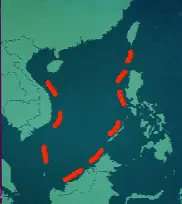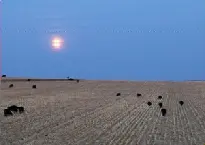I usually can only decode the Shortwave Radiogram program on Sunday evenings (local time) when conditions and frequencies line up to be perfect for the short transmission path from Florida. This morning I decided to tune in to the 15775 kHz channel, transmitted from WRMI. To my surprise there was very little fading on the signal and I was able to obtain a perfect copy (there is some noise on a couple of the images).
The last image, made of the RGB channels 0, 128, and 255, was really cool to watch (and listening to) coming across the radio. There were three distinct channels showing on the waterfall which were very distinct on MFSK64.
The program, decoded.
Welcome to program 163 of Shortwave Radiogram. I'm Kim Andrew Elliott in Arlington, Virginia USA. Here is the lineup for today's program, in MFSK modes as noted: 1:44 MFSK32: Program preview (now) 2:58 MFSK16: ARRL/TAPR conference call for papers 5:40 MFSK32: Highest-altitude mammal is a mouse* 11:03 MFSK64: China's South China Sea propaganda* 17:20 This week's images* 27:40 MFSK32: Closing announcements * with image(s) Please send reception reports to radiogram@verizon.net And visit http://swradiogram.net Twitter: @SWRadiogram Shortwave Radiogram now changes to MFSK16 ... Before RSID: <<2020-08-01T13:33Z MFSK-32 @ 7780000+1500>> This is Shortwave Radiogram in MFSK16 ... From ARRL.org: ARRL/TAPR Digital Communications Conference Seeks Papers 07/27/2020 Technical papers are being solicited for presentation at the 2020 ARRL/TAPR Digital Communications Conference (DCC), September 11 - 13. Due to the coronavirus pandemic, this year's conference will be held online. Papers will also be published in the Conference Proceedings. Authors do not need to participate in the conference to have their papers included in the Proceedings. The submission deadline is August 15, 2020. Submit papers via email to Maty Weinberg, KB1EIB, maty@arrl.org. Papers will be published exactly as submitted, and authors will retain all rights. https://bit.ly/3hOsh8Z Returning to MFSK32 ... Before RSID: <<2020-08-01T13:35Z MFSK-16 @ 7780000+1500>> This is Shortwave Radiogram in MFSK32 Please send your reception report to radiogram@verizon.net From Science News: A South American mouse is the world's highest-dwelling mammal Jack J. Lee 29 July 2020 A yellow-rumped leaf-eared mouse has shattered the world record as the highest-dwelling mammal yet documented. The mouse (Phyllotis xanthopygus rupestris) was found 6,739 meters, or 22,110 feet, above sea level on the summit of Volcán Llullaillaco, a dormant volcano on the border of Chile and Argentina. For comparison, Mount Everest is 8,848 meters high (29,029 feet). The record was previously held by the large-eared pika (Ochotona macrotis), reported at an altitude of 6,130 meters during a 1921 Mount Everest expedition. Birds have been found at even higher altitudes. That mammals can live at these heights is astonishing, considering there's only about 44 percent of the oxygen available at sea level. "It's very difficult to sustain any kind of physical activity, or mental activity for that matter," says Jay Storz, an evolutionary biologist at the University of Nebraska-Lincoln. The temperature is also rarely above freezing and can drop as low as -60° Celsius. Storz and colleagues captured several yellow-rumped leaf-eared mice, including the summit-topping one, plus mice from three other species from a range of high altitudes, the team reports July 16 in Proceedings of the National Academy of Sciences. Next, the team plans to look for genetic changes that might have equipped these animals to survive at high elevations. Surprisingly, another yellow-rumped leaf-eared mouse was found at sea level, indicating that this species has the broadest altitude distribution of any mammal, in addition to the altitude record. "It's so amazing that they're up there," says Graham Scott, a physiologist at McMaster University in Hamilton, Canada who was not involved in the study. Understanding how these and other animals survive under low-oxygen conditions could provide insight into how humans could overcome diseases that cause reduced oxygen levels, he says. https://www.sciencenews.org/article/south-american-mouse-world-highest-dwelling-mammal Sending Pic:208x147C;

Shortwave Radiogram changes to MFSK64 ... Before RSID: <<2020-08-01T13:41Z MFSK-32 @ 7780000+1500>> This is Shortwave Radiogram in MFSK64 Please send your reception report to radiogram@verizon.net From the Voice of America: China Launches Propaganda for Recognition of Disputed Maritime Claims Ralph Jennings 27 July 2020 TAIPEI, TAIWAN - Chinese scholars have had scores of reports published in internationally recognized scientific journals containing a mention of their country's 'nine-dash line,' the core of its claim to the hotly contested South China Sea, an American research institution said this month. China is using the journal pieces to promote its claimed demarcation line, Vietnamese scholar Nguyen Thuy Anh wrote in a July 15 article for the Asia Maritime Transparency Initiative under the Center for Strategic and International Studies. Journal articles are just China's latest effort to publicize its nine-dash line for a wide global audience in hopes that the constant reminders will legitimize its claim over the claims of other countries, analysts say. Maps, globes, postcards, T-shirts, video games and at least one blockbuster film influenced by China refer to the line as well. China has churned out those items for at least 10 years. "If you do slap a nine-dash line on say DreamWorks movies that get localized and distributed around the world, it does I think send a subtle message that (the) default world view should be that the nine-dash line is real and legitimate," initiative director Gregory Poling said. Nguyen, a research fellow at the East Sea Institute of the Diplomatic Academy of Vietnam, found 260 articles using the nine-dash line in 20 "prominent" scientific journals owned by various publishers, her report says. China vies for maritime sovereignty in the South China Sea with Brunei, Malaysia, the Philippines, Taiwan and Vietnam. At stake is a shared 3.5 million-square-kilometer sea valued for fisheries, energy reserves and commercial shipping lanes. Beijing claims about 90% of the waterway and has angered weaker neighbors over the past decade by landfilling tiny islets in the sea for military, economic and scientific use. China refers to the nine-dash line to back its sovereignty claim. The line, literally composed of nine thick dashes, swings south from the Chinese mainland, across waters east of Vietnam, near the north coast of Borneo, and back along the Philippine island of Palawan toward Taiwan. The thickness of lines plus the spaces between them make China's actual claims vague, analysts have said. Propaganda and constant reminder Chinese officials as well as private firms show the nine-dash line in passports, books, online games and tourist brochures, Nguyen said in her report. In cinema, the most internationally memorable example was a scene from "Abominable," an animated movie made by China-based Pearl Studio and America's DreamWorks Animation. The film was banned in Malaysia, the Philippines, and Vietnam last year because of the scene. Vietnamese officials in 2018 denounced the arrival of 14 Chinese tourists who flew into the Southeast Asian country wearing T-shirts showing the disputed line. Five years earlier Philippine booksellers quit selling made-in-China globes showing the Chinese demarcation line. The government in China, a major exporter of globes, last year published a notice aimed at ensuring that any map-bearing materials make the Chinese "position on territory clear to the international community," state-controlled media outlet Global Times online said. 'Target audience' China is aiming these materials at a "target audience" of Arab, African, and other "third countries" rather than Western consumers, Poling said. A student doing research in Africa, he said, would see probably the nine-dash line on a globe and not question it. Few world consumers know what the line means, said Jay Batongbacal, international maritime affairs professor at University of the Philippines. "Most of them don't notice it, because they're not really familiar with South China Sea issues, meaning this goes over their heads," Batongbacal said. "That's why China is doing this. It's like a subtle propaganda effort, which they will use later on to say the nine-dash line is well known to everybody because it's in all these products and articles and whatnot." China cites historical records to support its maritime claim. In 2016 a world arbitration court ruled against the claim's legal basis in the South China Sea. Southeast Asian countries that assert their maritime sovereignty, sometimes sparring with Chinese vessels in the contested sea, normally rely on 370-kilometer-wide exclusive economic zones extending from their coasts. People offshore and on are supposed to pay attention to the nine-dash line merchandising, said Huang Kwei-bo, vice dean of the international affairs college at National Chengchi University in Taipei. The Chinese government regularly reminds citizens of its achievements overseas to drum up support for the state and ruling Communist Party. "Its actions of this type actually have two points - one is to approach the international community and promote that the PRC has had the whole South China Sea forever, but another point of course is for what amounts to domestic patriotic education," Huang said. https://www.voanews.com/east-asia-pacific/china-launches-propaganda-recognition-disputed-maritime-claims Image: Map of the "nine-dash line" ... Sending Pic:182x204C;

This is Shortwave Radiogram in MFSK64 Please send your reception report to radiogram@verizon.net This week's images ... Cows graze in a pasture beneath a haze-filtered moon near Sioux Falls, South Dakota. From https://bit.ly/3geEoMb ... Sending Pic:205x145C;

The Phillie Phanatic sits alone in the stands during a game between the Miami Marlins and the Philadelphia Phillies at Citizens Bank Park on July 25, 2020, in Philadelphia. From https://bit.ly/3jWEw5t ... Sending Pic:194x170C;

A compound in the leaves of the American beautyberry boosts an antibiotic’s activity against antibiotic-resistant staph bacteria, according to Emory University research. From https://bit.ly/3k4WD9o ... Sending Pic:204x115C;

A fish swims in the Cineaqua Aquarium in Paris, which reopened its doors to visitors a few weeks ago. From https://bit.ly/3fifuKd ... Sending Pic:199x140C;

Zinnias at Burnside Farm in Nokesville, Virginia. From https://bit.ly/30abVSe ... Sending Pic:198x122C;

Our art of the week is this design by our listener and analyst Roger in Germany. It uses a mixture of colors in which there are only 3 values in the RGB channels: 0, 128 and 255 ... Sending Pic:161x161C;

Shortwave Radiogram returns to MFSK32 ... Before RSID: <<2020-08-01T13:57Z MFSK-64 @ 7780000+1500>> This is Shortwave Radiogram in MFSK32 ... Shortwave Radiogram is transmitted by: WRMI, Radio Miami International, wrmi.net and WINB Shortwave, winb.com Please send reception reports to radiogram@verizon.net And visit http://swradiogram.net Twitter: @SWRadiogram or twitter.com/swradiogram I'm Kim Elliott. Please join us for the next Shortwave Radiogram.